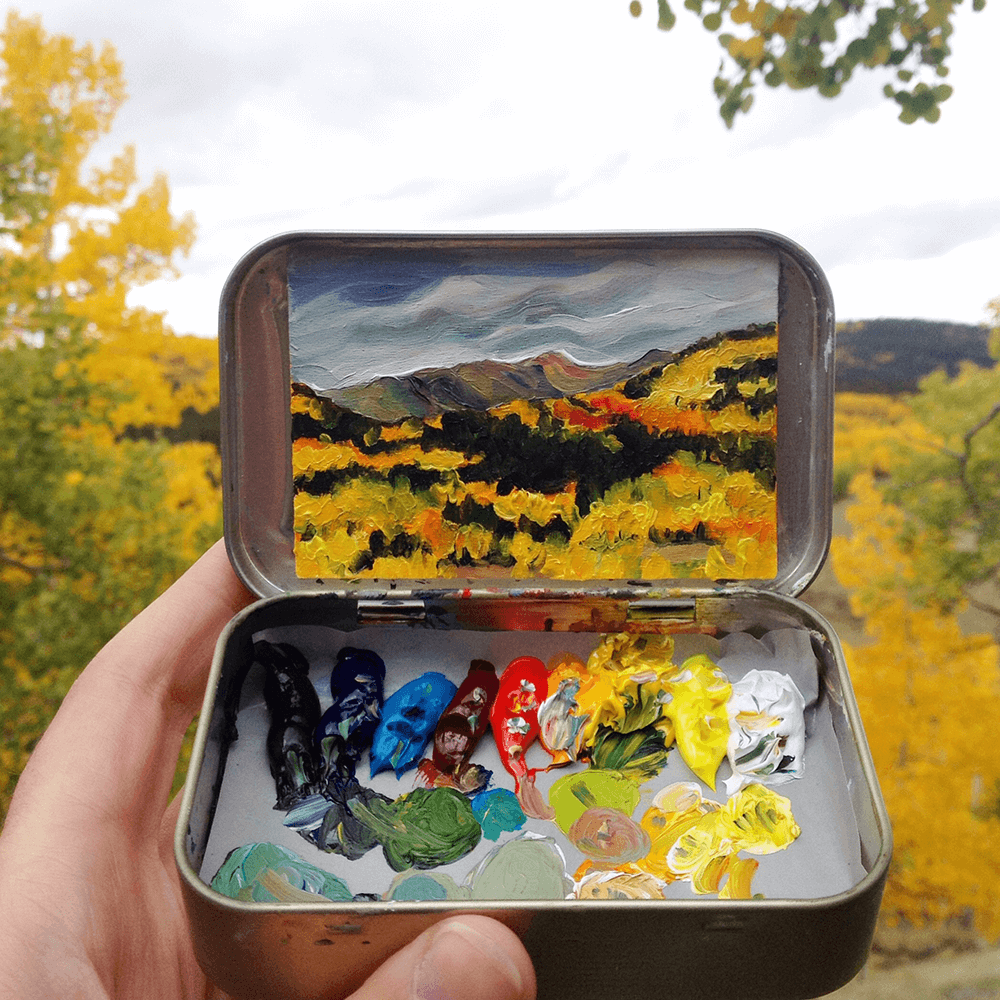
Portrait of the Artist is on Thanksgiving break and will be back next week.
After quitting her East Coast job as a translator, Heidi Annalise moved home to her native Colorado and became a painter. Despite not having a formal degree in art, Annalise sets out to various locales with a mint-tin for an easel and a small piece of panel for a canvas. Here, she discusses the miniature format of her work and why she loves her mountainous state.
“When I moved back to Colorado, I realized I not only had an interest in art but that I was living in a place where nature inspired me. For the first time, I was getting a vision of what kind of art I wanted to make. It started as a studio thing, but my first summer back here, I found a way of merging my interest in hiking and being outside with painting. Traditionally, oil painters have loved using heavy easels that fold up—they’re kind of complex and heavy. You put all this material together, you lug it up into the hills, you plant it somewhere, and you’re a sail for the wind. There are stories of artists who have their easels blown over, their paintings landing face-down in the gravel. It always seemed like such an ordeal to me that I was like, ‘Eh, I don’t know—outdoor painting doesn’t seem like something I want to get into.’ That’s when I had the idea to make it small and portable, and a bit more spontaneous. I wanted to stick with the tradition of oil paint; I just didn’t want the elaborate set up. I appreciate the vibrancy that oil paint offers. Without it, you couldn’t achieve the same saturation. Especially in Colorado, where the air is really dry, if you were to take acrylic paint out with you, it would dry to a crisp almost instantly.
When I was a little kid, I was fascinated with miniatures. I was completely obsessed with a Lego village I had created. It was an elaborate town—every single citizen had a name and a backstory. There was one resident who was an artist, so I made these tiny little paintings that were hanging up all over her house in the Lego village. That was the first artwork I was serious about. I was earnestly creating something so early in my life, and it was that tiny. I would say, as a rough estimate, that I’ve made about 200 of these mint-tin landscape paintings. I always feel a little bit ridiculous when I get on eBay and order 40 empty Altoid tins. I worry that I’m supporting an unhealthy dental habit for some mint addicts out there! I do enjoy the recycling element, though. I could get the same empty tins from a factory in China, but I like reusing the Altoid tins.
I’ve had several comments on social media to the effect of, ‘Why would an artist try to capture nature when a camera can do it better?’ To a point, I understand where they’re coming from, but I use landscape painting to capture more than just the reality of it. When people see one of my mint-tins and how it matches up with the background, they might think I’m trying to make it 100-percent accurate. But I would never want someone to tell me that my work is hyper-realistic. That’s not my aim. I might push a color a bit more to an extreme, or change a shape or do other things to manipulate the environment. I don’t want to represent what I see, but how I feel about what I’m seeing.
Painting gives me a sense of curiosity and the desire to explore different parts of the state. I’ve seen more of Colorado than I ever did when I was a teenager growing up here. Probably one of my favorite things is to capture the changing seasons. We have so many extremes in weather. Sometimes I go out and sit in the same places—the exact same spots—because at different points of the season, you can capture something entirely different. I don’t think this is something I’m ever going to get bored with—it’s a reminder for me to slow down and immerse myself in the landscape.”

